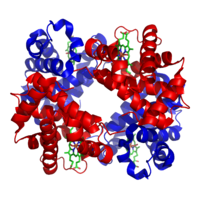
Photo from wikipedia
It has recently been demonstrated that the addition of nanoscale zero-valent iron (nZVI) to oxygen-containing water or soil aquifers results in the oxidation of organic compounds. However, there has been… Click to show full abstract
It has recently been demonstrated that the addition of nanoscale zero-valent iron (nZVI) to oxygen-containing water or soil aquifers results in the oxidation of organic compounds. However, there has been little insight about the generation of the reactive oxygen species (ROS) that play a vital role in the transformation of contaminants in the presence of nZVI. This study investigated (i) the degradation of 2-chlorobiphenyl (2-CB) by nZVI; (ii) the generation and role of ROS in this process. Under anaerobic and aerobic conditions, the removal efficiency of 2-CB was 65.5 and 59.4%, respectively, after 4 h at a pH of 5.0. The results demonstrated that both the reductive and oxidative processes account for 2-CB degradation under aerobic conditions. Hydroxyl radicals (·OH) generated by nZVI at low pH could efficiently degrade 2-CB, the main reductive dechlorination product was biphenyl. Two other hydroxylation products (2-chlorophenol and 2-hydroxybiphenyl) were also examined. There was a higher degradation efficiency of 2-CB under acidic conditions than basic conditions because more ·OH was generated by nZVI. The presence of natural organic matters (NOMs), including humic acid (HA), salicylic acid (SA), galic acid (GA), and tannic acid (TA), increased the degradation efficiency of 2-CB (k values ranged from 0.0041 to 0.0042 min−1), because NOMs can mediate the electron transfer from the nZVI surface to O2, and facilitate the production of Fe2+ and H2O2 that subsequently form ·OH. The mechanisms of these processes have provided new insights into the role of nZVI in the transformation of organic compounds.
Journal Title: Environmental Science and Pollution Research
Year Published: 2017
Link to full text (if available)
Share on Social Media: Sign Up to like & get
recommendations!